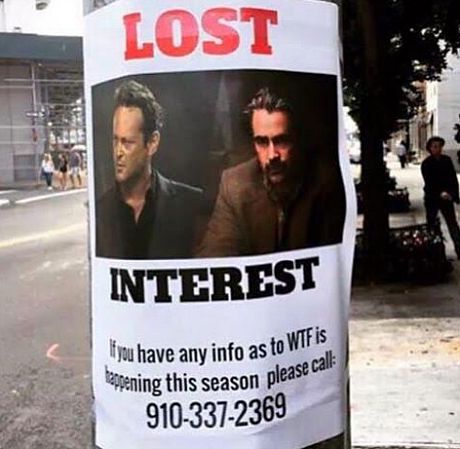
Day: July 16, 2015
Sun Ain’t Gonna Shine Any More
I’ve watched this trailer twice, and it seems obvious that Tom Hardy is grand-slamming it here. Shake hands with a pair of genetically linked fellows who are nonetheless somewhat different physically and also separated by temperament and outlook (i.e., one being half-crazy). He’s probably a lock for Best Actor — this is stunt casting and high-wire performing on a level that’ll be hard to dismiss. I’d really like to see this play Venice + Telluride but who knows? If I was Universal marketing honcho Michael Moses and Uni Oscar consultant Tony Angelotti I’d be taking Legend to both festivals plus Toronto to make it clear that Hardy’s performance demands award-season attention.
Unable To Crash Before Midnight
It took me a long time to recover from my various childhood traumas, first and foremost being the son of an alcoholic dad. Another was always being ordered to bed too early in my pre-tweener years. Even during the summer months with the sun not fully down for the count until 9 or 9:30 pm I would be sent to bed at 8 or 8:30 pm. Looking out at the dusk-lit neighborhood street from my bedroom window and listening to kids still playing outside was infuriating. The only time I was allowed to stay up later was when I stayed with my paternal grandparents, who were much more liberal. I swore up and down I would stay up as late as possible when I got older, and that’s still the case today. I can’t bring myself to hit the sack until midnight or thereabouts, even if I’m exhausted. The idea of going to bed early is generally intolerable. I’d say this is 60% or 70% due to my Harrison Avenue repression plus standard FOMO. It also spawned a determination to err on the side of liberalness when it came to my own kids. Even when they were really young I’d let them stay up until midnight on weekends. All because of Jim and Nancy and their belief in a Gulag Archipelago environment.
Dawn of Culture Wars
Morgan Neville and Robert Gordon‘s Best of Enemies (Magnolia), one of the year’s finest docs and one of my hands-down faves during last January’s Sundance Film Festival, will open on 7.15. On one level a spry, highly intelligent history of the ABC TV debates between William F. Buckley, Jr. and Gore Vidal during the Democratic and Republic national conventions of ’68. On another level a capturing of a time and a pre-Fox News political climate that no longer exists — even with the police riot on the Chicago streets and the acrimony that eventually engulfed Buckley when he lost his temper and called Vidal a “queer”, the summer of ’68 was nonetheless a time of relative civility when it came to right-left disputes. And yet the debates were also a harbinger of the culture wars that began…when, during the Nixon administration? I’m hoping to see this again and sit down with Neville (director of the Oscar-winning 20 Feet From Stardom) before it opens.
Proof in VistaVision Pudding
In yesterday’s piece about the intention of Universal and Martin Scorsese‘s The Film Foundation to join forces on a 4K “restoration” of One Eyed Jacks, I stated that the only acceptable aspect ratio for the resulting Bluray will be 1.66:1. I explained that 8-perf VistaVision, which was Paramount’s “house” process during the burgeoning widescreen days of the mid 1950s, delivered an in-camera aspect ratio of 1.5:1 but was mastered in 1.66:1 from the mid to late ’50s. Others disagreed, claiming the a.r. should be 1.85. This is pure Furmanek, pure fascist reflex. I will maintain to my dying day that 1.85 is too radical for 1950s and early ’60s films — it chops off too much information.
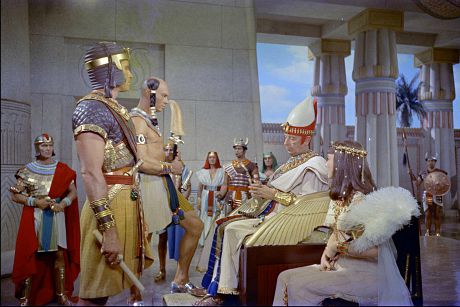
Default full-aperture VistaVision aspect ratio: 1.5:1.
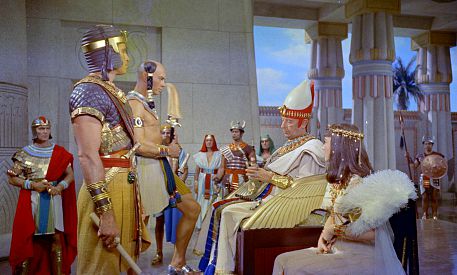
1.66:1.
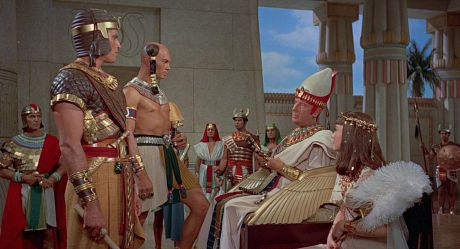
1.85:1.
Above, to prove my point, are three images from Cecil B. DeMille‘s The Ten Commandments, which was shot in VistaVision. The top image shows the full image capture, which is roughly 1.5:1. Notice that Sir Cedric Hardwicke‘s sandaled feet are sitting on top of what looks like a plain wooden box or platform of some kind — obviously not meant to be seen. The second or middle image is a crop I’ve done at an a.r. of 1.66:1. Notice that I’ve gotten rid of the box but with a bit more breathing room above Yul Brynner and Charlton Heston‘s heads. It’s pleasing and airy and not overly cramped. (And without distractions like Hardwicke’s foot rest, most of the 1.66 framings would be much more balanced.) The bottom image, cropped at 1.85, is from the finished film. Notice the lack of breathing room, a cramped feeling. It almost looks like the characters don’t have enough oxygen.
One-Sided Discourse
In her Trainwreck review N.Y. Times critic Manohla Dargis says Amy Schumer is her “kind of superhero because she stops haters dead,” haters defined in this context as chauvinists who mouth “hateful slurs” by saying this or that woman isn’t “thin enough or pretty enough.”
I suffered slings and arrows along these lines a few months ago but that train has left the station. I fell in love with Schumer after seeing Trainwreck because I was persuaded that the movie version of “Amy” is who Schumer really is deep down, and that realization touched me like very few comedies have in my entire life. I’ll never say a word against her again. But without disputing that it’s uncool to throw cruel comments around or that Schumer’s 12 Angry Men riff was an on-target parody of male sexist attitudes, let’s take two steps back and examine Dargis’s brief.
By saying that it’s hateful for men to judge women for their looks, Dargis is addressing only half of the activity that happens worldwide on a daily basis. As men have regarded visual female allure as a major deal for many, many centuries, I doubt if this trait is going to disappear any time soon. The sin, if I correctly understand Dargis and the haters who were after my blood last February, is discussing these judgments in a public forum. Why? Because it hurts. And because such judgments are never conveyed privately when a guy isn’t interested in pursuing a relationship with a woman — he just makes up an excuse of some kind, not wanting to hurt anyone’s feelings.
Friends of Trainwreck #2
From Manohla Dargis’s N.Y. Times review: “Amy Schumer is my kind of superhero — she stops haters dead. As fans of her Comedy Central show, Inside Amy Schumer, know, there’s almost nothing that anyone can say about women, her included, that she hasn’t already said herself. Her powers of deflection are the perfect approach in a neofeminist moment in which women are calling out sexists, sometimes against vicious pushback. Think that she’s not thin enough or pretty enough? She intercepts hateful slurs like those and turns them into ferocious comedy gold that exposes chauvinism as the absurdity it is. She can’t be stereotyped away as a sourpuss who just needs to chill out, lie back and smile. She’s already smiling, and she’s killing it, joke after joke.
“In Trainwreck, Ms. Schumer plays, well, Amy, a more vanilla version of one of her comically flawed women, who aren’t as remotely together as they think or may appear to be. The movie, which was directed by Judd Apatow from her script, is often extremely funny, even if it never approaches the radicalness of her greatest, most dangerous work. Mr. Apatow’s talent as a movie director is opening up a space on screen in which comic performers (and some total stiffs) can be effortlessly funny together. In Trainwreck, he creates a roomy, comfortable vehicle stuffed with second bananas (both professional zanies and guest-starring squares), who support Ms. Schumer as she tosses out jokes, pops her eyes, deploys her deadpan and shows off her gift for old-school physical high jinks, often in heels and minis.
Where’d You Go, Johnny Concho?
This may not pass muster with traditional Western devotees (i.e, readers of Cowboys & Indians) but arguably one of the most influential westerns ever made is Johnny Concho (’56), a stagey, all-but-forgotten little film that Frank Sinatra starred in and co-produced. For this modest black-and-white enterprise was the first morally revisionist western in which a big star played an ethically challenged lead character — i.e., a cowardly bad guy.
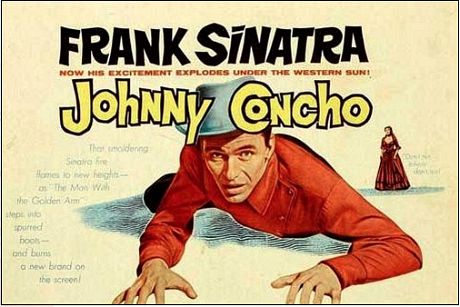
The conventional line is that Marlon Brando‘s One-Eyed Jacks was the first western in which a major star played a gunslinging outlaw that the audience was invited to identify or sympathize with — a revenge-driven bank robber looking to even the score with an ex-partner (Karl Malden‘s “Dad” Longworth) who ran away and left Brando’s “Rio” to be arrested and sent to prison.
This opened the door, many have noted, to Paul Newman‘s rakishly charming but reprehensible Hud Bannon in Martin Ritt‘s Hud two years later, and then the Spaghetti westerns of Sergio Leone (beginning with ’64’s A Fistful of Dollars) and particularly Clint Eastwood‘s “Man With No Name.”
But before One-Eyed Jacks audiences were presented with at least three morally flawed western leads portrayed by name-brand actors. First out of the gate was Sinatra’s’s arrogant younger brother of a notorious gunslinger in Concho. This was followed in ’57 by Glenn Ford‘s Ben Wade, a charmingly sociopathic gang-leader and thief, in Delmer Daves‘ 3:10 to Yuma. And then Paul Newman‘s Billy the Kid in Arthur Penn‘s The Left-Handed Gun (’58).
